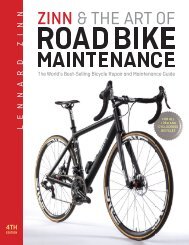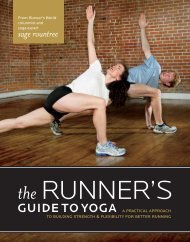Zinn & The Art Of Mountain Bike Maintenance - VeloPress
Zinn & The Art Of Mountain Bike Maintenance - VeloPress
Zinn & The Art Of Mountain Bike Maintenance - VeloPress
You also want an ePaper? Increase the reach of your titles
YUMPU automatically turns print PDFs into web optimized ePapers that Google loves.
4.3 Wiping the jockey wheels with a rag 4.4 Using a solvent-bath chain cleaner<br />
1. Grab the chain with a rag. Grasp the lower<br />
length of the chain (between the bottom of<br />
the chainring and the rear-derailleur lower<br />
jockey wheel).<br />
2. Turn the crank backward a number of revo-<br />
lutions. Pull the chain through the rag (Fig.<br />
4.2). Periodically rotate the rag to present a<br />
cleaner section of it to the chain.<br />
3. Lubricate the chain as in §iv-1.<br />
To encourage regular care, leave a pair of rub-<br />
ber gloves, a rag, and some chain lube next to your<br />
bike. <strong>The</strong>n, whenever you return from a ride, put on<br />
the gloves, wipe and lube the chain, and put your<br />
bike away. It takes maybe a minute, your hands<br />
stay clean, and your bike is ready for the next ride.<br />
If you can find time to take a shower after you ride,<br />
you can find time for this. Wipe the chainrings,<br />
cogs, front derailleur, and jockey wheels (Fig. 4.3)<br />
while you’re at it, and the entire drivetrain will<br />
always work ideally.<br />
iv-3<br />
USING CHAIN-CLEANING UNITS<br />
Several companies make chain-cleaning units<br />
that scrub the chain with a solvent while it is<br />
on the bike. <strong>The</strong>se chain cleaners are generally<br />
Sample from <strong>Zinn</strong> & the <strong>Art</strong> of <strong>Mountain</strong> <strong>Bike</strong> <strong>Maintenance</strong>, 5th Ed.<br />
Copyright 2010 <strong>VeloPress</strong> All rights reserved<br />
made of clear plastic and have two or three<br />
rotating brushes that scrub the chain as it moves<br />
through the solvent bath (Fig. 4.4). <strong>The</strong> units offer<br />
the advantage of letting you clean the chain<br />
without removing it from the bike. Regularly<br />
removing the chain shortens any chain’s life;<br />
moreover, with 9- or 10-speed chains unless you<br />
use a master link, you may find that the chain<br />
breaks under high load, thereby driving your foot,<br />
and perhaps your entire body, into the ground.<br />
Most chain-cleaning units come with a non-<br />
toxic, citrus-based solvent. For your safety, and<br />
other environmental reasons, I strongly recom-<br />
mend that you purchase nontoxic citrus solvents<br />
for the chain-cleaning unit, even if it already<br />
comes with a petroleum-based solvent. If you<br />
recycle used diesel fuel, then go ahead and use it.<br />
In any case, wear gloves and glasses when using<br />
any solvent.<br />
Citrus chain solvents often contain some<br />
lubricants, so they won’t dry the chain out. <strong>The</strong><br />
combination of lubricant and solvent is why diesel<br />
fuel has had such a following as a chain cleaner.<br />
A really strong solvent without lubricant (acetone,<br />
for example) will displace the oil from inside the<br />
rollers. <strong>The</strong> solvent will later evaporate, leaving a<br />
CHAPTER 4<br />
53<br />
CHAINS














